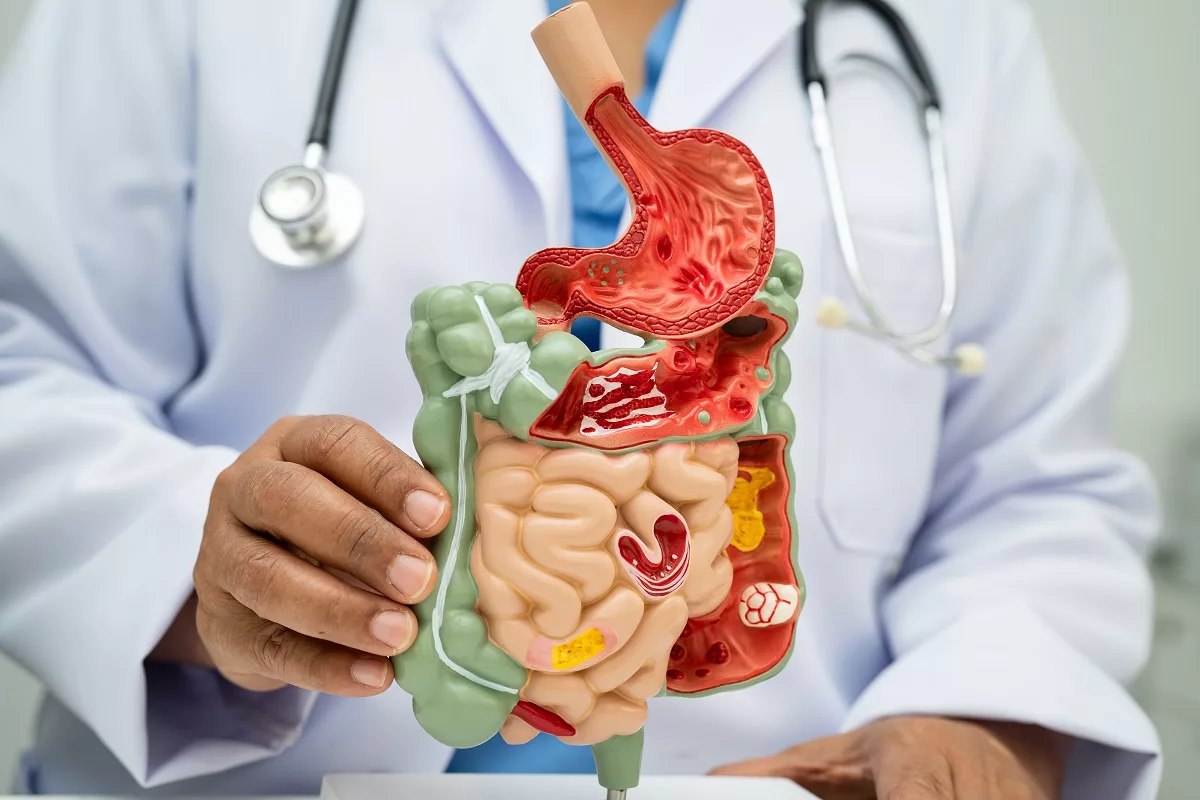This is a colon (large intestine) condition that causes swelling (inflammation) and irritation of the intestine. The most common symptom of microscopic colitis is watery diarrhea. The name of the condition comes from the colon tissue seen under the microscope. However, large intestine tissue usually appears typical on examinations with a colonoscopy or flexible sigmoidoscopy. Check below some subtypes of microscopic colitis:
- Collagenous colitis – It occurs when collagen (a thick layer of protein) grows in the tissue of the colon.
- Lymphocytic colitis – In such cases, the lymphocyte (white blood cells) levels increase in the colon tissue.
Healthcare providers believe that both subtypes are the same condition. Furthermore, symptoms, tests, and treatments are the same for both subtypes of microscopic colitis.
Symptoms
People with this type of colitis usually experience the following symptoms. Examples include:
- Nausea
- Watery diarrhea
- Abdominal cramps or pain
- Weight loss
- Bloating
- Fecal incontinence (inability to control bowel movements)
- Dehydration (reduced water in the body)
In most cases, the symptoms of microscopic colitis come and go and sometimes, the symptoms may disappear on their own.
If you experience any of the previous symptoms and they last more than several days, immediately contact your healthcare provider.
Causes
Experts do not know the exact cause of swelling and irritation of the large intestine often found in people with microscopic colitis. However, some healthcare providers believe a combination of factors contributes to it. For example:
- Medications that cause inflammation of the lining of the large bowel.
- Bile acid that is not absorbed properly may also cause inflammation of the intestinal lining.
- Bacteria that produce viruses or toxins may negatively affect the lining of the colon.
- Autoimmune diseases linked to microscopic colitis (including rheumatoid arthritis, celiac disease, or psoriasis). These health conditions often appear when the immune system mistakenly attacks healthy tissues instead of viruses, bacteria, and other germs.
Risk Factors
Check below some factors that may increase your risk of developing this type of colitis:
- Age – In most cases, this condition is diagnosed in people over 50 years old.
- Sex – Females are more prone to develop microscopic colitis compared to men. There are some studies that suggest a connection between post-menopausal hormone therapy and this type of condition.
- Autoimmune disease – In some cases, people with microscopic colitis also have an autoimmune disorder such as celiac disease, thyroid disease, rheumatoid arthritis, type 1 diabetes, or psoriasis.
- Genetics – As per studies, there are some genes that may be linked with this colitis type. Furthermore, a family history of irritable bowel syndrome also increases the risk of microscopic colitis.
- Smoking – People who smoke are at elevated risk of developing microscopic colitis.
Some research showed a connection between some medications and an increased risk of microscopic colitis. Check below some medicines that are potentially linked with this condition:
- Over-the-counter (OTC) pain relievers (such as Ibuprofen, Naproxen sodium, and others)
- Proton pump inhibitors (these include Lansoprazole, Esomeprazole, Pantoprazole, Rabeprazole, Omeprazole, and Dexlansoprazole)
- Selective serotonin reuptake inhibitors (SSRIs), including Sertraline
- Acarbose
- Flutamide
- Ranitidine
- Carbamazepine
- Clozapine
- Entacapone
- Paroxetine
- Simvastatin
- Topiramate
Complications
Usually, people do not experience any complications if the condition is successfully treated and does not increase the risk of colon cancer. However, some people may experience some of them. For example:
- Colon perforation
- Ulcers
- Toxic megacolon
- Other immune-related conditions (for example, celiac disease, rheumatoid arthritis, psoriasis, and others)
Talk with your healthcare professional about ways to prevent complications of this condition.
Diagnosis
First, doctors will perform a physical examination to check for abnormalities linked with the disease and ask some questions about your symptoms and medical history. Thereafter, they usually perform some tests to confirm the disease and rule out others that cause similar symptoms. Check below some tests used to diagnose this type of condition:
- Colonoscopy and biopsies – These procedures allow your doctor to see inside the large intestine. To perform these tests, doctors use a long and flexible tube with a lighted camera on the end (also called a colonoscope). During the colonoscopy, physicians may take a small sample of the affected tissue and test it in the laboratory.
- Flexible sigmoidoscopy – This test is similar to colonoscopy, but allows the doctor to see inside the most of sigmoid colon and rectum. It is approximately the last 1-2 feet (30 to 60 centimeters) of the colon.
The only test that helps doctors confirm the disease is a biopsy because the tissue of the intestine appears typical in people with microscopic colitis.
Other Tests
The following tests are often used to exclude other health conditions that cause similar symptoms. Examples include:
- Stool sample study
- Blood tests are used to check for anemia or celiac disease
- Upper endoscopy with biopsy
Treatment
While some people notice improvements without treatment, others need lifestyle changes, medicines, and even surgery to treat the disease. Check below some treatments often recommended by doctors for people with microscopic colitis.
Dietary Changes
The treatment for microscopic colitis usually starts with dietary changes and medicines to lessen diarrhea. Check below some dietary changes:
- Eat a low-fat and low-fiber diet – Foods that contain less fat and fiber may help relieve diarrhea.
- Limit dairy products, gluten, caffeine, and sugar – These foods may worsen the symptoms.
In addition, if you experience this colitis type due to certain medicines, you may need to reduce the dose or even change the medicine to treat the disease.
Medicines
The following medicines are used to relieve the symptoms and treat microscopic colitis. Examples include:
- Anti-diarrheal medications (such as Loperamide, Bismuth subsalicylate, and others)
- Steroids (including Budesonide)
- Medications to block bile acids (such as Cholestyramine/Aspartame, Colestipol, and others)
- Biological medications – These medicines may help reduce irritation and swelling (inflammation) in the large intestine.
- Medications used to suppress the immunity – For example Mercaptopurine, Azathioprine, and others. These medicines may help lessen swelling in the colon.
Surgery
In rare cases, people need surgery to treat this type of colitis. During this procedure, surgeons will remove a part or all of your large intestine. It is usually recommended when medicines do not work and for people with severe microscopic colitis.
Frequently Asked Questions
What foods should you avoid with microscopic colitis?
These include:
- Spicy foods (including hot sauces, chilies, and hot peppers)
- High-fiber (including whole grains, beans, lentils, nuts, seeds, and others) and high-fat foods
- Dairy products
- Caffeine
- Alcohol
- Artificial sweeteners
- Red and processed meats
For more details, discuss it with your doctor.
How do you treat microscopic colitis?
Usually, doctors recommend medicines to treat this condition. Some people get rid of the condition without treatment. They usually prescribe immunosuppressants (such as Mercaptopurine and Azathioprine) and biological medicines (including infliximab, Adalimumab, or Vedolizumab). In severe cases, people may need surgery.
What happens if microscopic colitis is left untreated?
People who do not treat the condition may experience some complications. For example chronic or recurrent diarrhea, reduced quality of life, dehydration, unusual weight loss, and others. Discuss with your healthcare professional about ways to prevent complications. Ask your doctor if you have any other questions.




